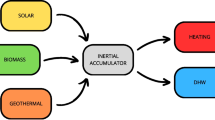Abstract
The goal of this study was to test many models in order to check which one better predicted the heat exchanger of a bioclimatic building. A number of regression models, pre-processing methods, and data analyses are compared in the study to forecast the input collector temperature of the heat pump. Specifically, three different techniques have been considered in this research work: Multilayer Perceptrons, Long Short Term Memory networks and Convolutional Neural Networks. Satisfactory results have been obtained in all cases for predicting the temperature 24 h in advance, implementing an useful tool for enhance energy management.
Access this chapter
Tax calculation will be finalised at checkout
Purchases are for personal use only
Similar content being viewed by others
References
Baruque, B., Porras, S., Jove, E., Calvo-Rolle, J.L.: Geothermal heat exchanger energy prediction based on time series and monitoring sensors optimization. Energy 171, 49–60 (2019)
Cheker, Z., Chakkor, S., El Oualkadi, A.: Visual evoked potential classification support with convolutional neural network and recurrent neural network-a comparative study. In: 2022 International Conference on Decision Aid Sciences and Applications (DASA), pp. 1612–1617. IEEE (2022). https://doi.org/10.1109/DASA54658.2022.9765034
Dickson, M.H., Fanelli, M.: Geothermal Energy: Utilization and Technology. Routledge (2013)
(EC), E.C.: Europe 2020: A Strategy for Smart, Sustainable and Inclusive Growth. Working Paper (COM 2010) (2010)
Energy, G.: Data page: geothermal energy capacity. (2023). https://ourworldindata.org/grapher/installed-geothermal-capacity. Accessed 20 May 2024
Florides, G., Kalogirou, S.: Ground heat exchangers’a review of systems, models and applications. Renew. Energy 32(15), 2461–2478 (2007). https://doi.org/10.1016/j.renene.2006.12.014
Hassan, Q., et al.: A comprehensive review of international renewable energy growth. Energy Built Environ. (2024)
Idroes, G.M., Hardi, I., Hilal, I.S., Utami, R.T., Noviandy, T.R., Idroes, R.: Economic growth and environmental impact: assessing the role of geothermal energy in developing and developed countries. Innov. Green Developm. 3(3), 100144 (2024)
Igeland, P., Schroeder, L., Yahya, M., Okhrin, Y., Uddin, G.S.: The energy transition: the behavior of renewable energy stock during the times of energy security uncertainty. Renew. Energy 221, 119746 (2024)
Jiang, A., Qin, Z., Faulder, D., Cladouhos, T.T., Jafarpour, B.: Recurrent neural networks for short-term and long-term prediction of geothermal reservoirs. Geothermics 104, 102439 (2022). https://doi.org/10.1016/j.geothermics.2022.102439
Kakaç, S., Liu, H., Pramuanjaroenkij, A.: Heat Exchangers: Selection, Rating, and Thermal Design, Designing for Heat Transfer, 2nd edn. Taylor & Francis(2002)
Kiranyaz, S., Avci, O., Abdeljaber, O., Ince, T., Gabbouj, M., Inman, D.J.: 1d convolutional neural networks and applications: a survey. Mech. Syst. Signal Process. 151, 107398 (2021). https://doi.org/10.1016/j.ymssp.2020.107398
Naser, M., Alavi, A.H.: Error metrics and performance fitness indicators for artificial intelligence and machine learning in engineering and sciences. Architect. Struct. Construct. 3(4), 499–517 (2023). https://doi.org/10.1007/s44150-021-00015-8
Ozgener, L.: A review on the experimental and analytical analysis of earth to air heat exchanger (EAHE) systems in turkey. Renew. Sustain. Energy Rev. 15(9), 4483–4490 (2011). https://doi.org/10.1016/j.rser.2011.07.103
Ozgener, L., Ozgener, O.: Monitoring of energy exergy efficiencies and exergoeconomic parameters of geothermal district heating systems (GDHSS). Appl. Energy 86(9), 1704–1711 (2009). https://doi.org/10.1016/j.apenergy.2008.11.017
Ozgener, O., Ozgener, L.: Modeling of driveway as a solar collector for improving efficiency of solar assisted geothermal heat pump system: a case study. Renew. Sustain. Energy Rev. 46, 210–217 (2015). https://doi.org/10.1016/j.rser.2015.02.043
Puppala, H., Saikia, P., Kocherlakota, P., Suriapparao, D.V.: Evaluating the applicability of neural network to determine the extractable temperature from a shallow reservoir of puga geothermal field. Int. J. Thermofluids 17, 100259 (2023). https://doi.org/10.1016/j.ijft.2022.100259
Rezaei, A., Kolahdouz, E., Dargush, G., Weber, A.: Ground source heat pump pipe performance with tire derived aggregate. Int. J. Heat Mass Transf. 55(11–12), 2844–2853 (2012). https://doi.org/10.1016/j.ijheatmasstransfer.2012.02.004
Sauer, H., Howell, R.: Heat Pump Systems. Krieger Publishing Company (1991)
Sayed, E.T., Olabi, A.G., Alami, A.H., Radwan, A., Mdallal, A., Rezk, A., Abdelkareem, M.A.: Renewable energy and energy storage systems. Energies 16(3), 1415 (2023)
Sotavento. (2023). https://www.sotaventogalicia.com/area-tecnica/instalaciones-renovables/minieolica/. Accessed 13 Jan 2024
Zhao, Z., Chen, W., Wu, X., Chen, P.C., Liu, J.: LSTM network: a deep learning approach for short-term traffic forecast. IET Intel. Transport Syst. 11(2), 68–75 (2017). https://doi.org/10.1049/iet-its.2016.0208
Acknowledgments
This work is financed by National Funds through the Portuguese funding agency, FCT - Fundação para a Ciência e a Tecnologia within project 2022.06822.PTDC (https://doi.org/10.54499/2022.06822.PTDC). The work of Pedro Oliveira was supported by the doctoral Grant PRT/BD/154311/2022 financed by the Portuguese Foundation for Science and Technology (FCT), and with funds from European Union, under MIT Portugal Program. CITIC is funded by the Xunta de Galicia through the collaboration agreement between the Consellería de Cultura, Educación, Formación Profesional e Universidades and the Galician universities for the reinforcement of the research centres of the Galician University System (CIGUS). This work has been supported by Centro Mixto de Investigación UDC-NAVANTIA (IN853C 2022/01), funded by GAIN (Xunta de Galicia) and ERDF Galicia 2021-2027.
Author information
Authors and Affiliations
Corresponding author
Editor information
Editors and Affiliations
Rights and permissions
Copyright information
© 2024 The Author(s), under exclusive license to Springer Nature Switzerland AG
About this paper
Cite this paper
Oliveira, P., Arcano-Bea, P., Marcondes, F.S., Calvo-Rolle, J.L., Novais, P., Jove, E. (2024). Geothermal Heat Exchanger’s Temperature Input Sensor Prediction Based on Deep Learning Modelling Technique. In: Zayas-Gato, F., Díaz-Longueira, A., Casteleiro-Roca, JL., Jove, E. (eds) Distributed Computing and Artificial Intelligence, Special Sessions III - Intelligent Systems Applications, 21st International Conference. DCAI 2024. Lecture Notes in Networks and Systems, vol 1173. Springer, Cham. https://doi.org/10.1007/978-3-031-73910-1_5
Download citation
DOI: https://doi.org/10.1007/978-3-031-73910-1_5
Published:
Publisher Name: Springer, Cham
Print ISBN: 978-3-031-73909-5
Online ISBN: 978-3-031-73910-1
eBook Packages: Intelligent Technologies and RoboticsIntelligent Technologies and Robotics (R0)




